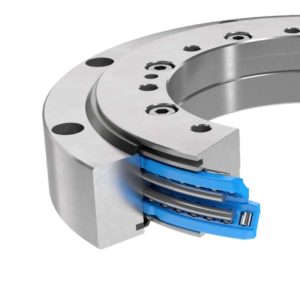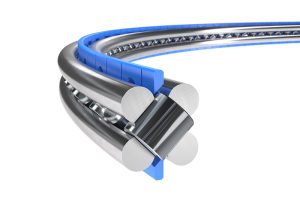Wire Race Bearing
Table of Contents
Definition of Wire Race Bearing
A wire race bearing is a type of rolling-element bearing that uses precision-ground hardened steel wire rings as raceways (the tracks on which the rolling elements move). Instead of traditional solid steel raceways, the bearing relies on these wire loops to guide the balls or rollers, reducing friction and enabling smooth motion.

FHD Bearings is an ISO 9001:2015-certified manufacturer and supplier of Wire Race Bearings, offering an extensive inventory with 1,200+ sizes and over 250,000 bearings in stock.
Materials of Wire Race Bearing
Wire Raceways (Race Rings)
- Hardened Stainless Steel (e.g., AISI 440C, 52100, or similar alloys)
- Provides excellent wear resistance and corrosion protection.
- Common in medical, aerospace, and marine applications.
- Precision-Ground Tool Steel (e.g., M50, ASP23, or similar)
- Offers high hardness and fatigue resistance for extreme loads.
- Often used in high-speed or high-precision industrial applications.
- Nitrided or Carburized Steel (for increased surface hardness)
- Used in situations requiring added surface durability while maintaining toughness.
Retainers (Cages or Separators)
- Polymer (e.g., PEEK, PTFE, Nylon, Delrin)
- Low friction, lightweight, and resistant to wear & chemicals.
- Ideal for high-speed and clean environments (medical, semiconductor).
- Stainless Steel or Brass
- Strong and durable for high-load or high-speed applications.
Lubrication Options
- Dry Lubricants (e.g., Molybdenum Disulfide, Graphite, PTFE coatings)
- Used in vacuum or extreme environments (space, cleanrooms).
- Grease (e.g., PFPE, Silicone-based, Lithium Complex)
- Provides long-term lubrication in standard conditions.
- Oil Lubrication (Mineral or Synthetic)
- For high-speed applications requiring fine friction control.

Rolling Elements (Balls or Rollers)
- Ceramic Balls (e.g., Silicon Nitride, ZrO₂)
- Ultra-low friction, corrosion-proof, and electrically insulating.
- Ideal for high-speed, vacuum, or chemically aggressive environments.
- Stainless Steel Balls (AISI 440C, 316L)
- Corrosion-resistant and durable; common in food, medical, or marine uses.
- Chrome Steel Balls (SAE 52100, high-carbon steel)
- High hardness and fatigue resistance; standard in industrial bearings.
Specialized Coatings (Optional)
- DLC (Diamond-Like Carbon) Coating
- Reduces friction, prevents wear, and increases lifespan.
- TiN (Titanium Nitride) or CrN (Chromium Nitride) Coating
- Improves hardness and corrosion resistance.
- Silver Plating (for conductive applications)
Features of Wire Race Bearing

- Lightweight & Compact – The wire race design reduces weight and material use compared to solid race bearings, making it ideal for weight-sensitive applications like aerospace and robotics where every gram matters.
- Low Friction – The precision-ground raceways minimize friction, improving efficiency and enabling smoother performance in high-speed applications like medical devices and precision instruments.
- High Precision & Rigidity – Ideal for applications requiring smooth, controlled rotation, such as optical alignment systems, CNC machinery, and robotic arms where minimal backlash is critical.
- Corrosion Resistance – Often paired with stainless steel or coated wires for durability, ensuring long-lasting performance in harsh environments like marine, chemical, or medical sterilization settings.
Taxonomy of Wire Race Bearing
Wire Race Bearing

Slewing Bearing with Wire Race Bearing
Slewing bearing with wire race design optimizes rotational efficiency, reducing friction and enhancing load distribution in machinery, ensuring smooth and precise movement.

Wire Race Bearings Elements
Wire Race Bearings Elements are an important part of the slewing ring with wire race bearings.
Applications of Wire Race Bearing
- Aerospace & Defense – Used in satellites, drone gimbals, and missile systems for lightweight precision.

- Medical Robotics – Critical for MRI machines, surgical robots, and portable medical devices.
- Semiconductor & Optics – Ideal for wafer handling, laser cutters, and telescopes.
- Marine & Subsea – Weather-resistant operation in underwater ROVs and sonar systems.
- Industrial Automation – Enhances CNC machines, 3D printers, and robotic arms.
- Energy & High-Tech – Used in wind turbines and particle accelerators for reliable performance.
Key Manufacturing Process of Wire Race Bearing
Material Selection
High-grade steel, ceramic, or titanium wires and balls for durability.
Precision Wire Forming
Raceways drawn/shaped to tight tolerances (±0.001mm).
Heat Treatment
Hardening and stress relief for wear resistance.
Grinding & Finishing
Ultra-smooth surface (Ra < 0.2µm) via CNC grinding/lapping.
Assembly & Preload
Controlled ball/roller insertion for zero play.
Testing & QC
Load, torque, and lifespan validation (millions of cycles).


FAQ - Frequently Asked Questions

Wire race bearings are a type of rolling-element bearing where the inner and outer rings consist of hardened steel wires instead of solid rings. They offer high precision and low friction, ideal for rotating applications with limited space.
Unlike conventional bearings, wire race bearings have minimal cross-sections, reducing weight while maintaining rigidity. They also handle higher misalignment and are easier to preload for precision applications.
These bearings are commonly used in aerospace, robotics, medical devices, and high-precision machinery where lightweight, compact, and low-friction motion is critical.
Yes, most wire race bearings need grease or dry film lubrication to minimize wear. Some self-lubricating versions are available, but regular maintenance is still recommended for optimal performance.
Load capacity depends on the bearing type, material, and design. They can handle moderate radial and axial loads but are not ideal for extreme heavy-duty applications.
They must be press-fit (or thermally expanded for tight fits) with precise alignment. Misalignment can cause premature wear, so dial indicators are recommended for accurate positioning.
Common causes include contamination (dust/debris), improper preload, excessive misalignment, lack of lubrication, and shock loads. Periodic inspection helps prevent these issues.
Yes, they operate well at high speeds due to low friction. However, rotational limits vary by model—consult manufacturer specs to avoid overheating or excessive wear.
Standard versions are made from hardened steel and require protection in humid or corrosive environments. Stainless steel or coated variants offer better corrosion resistance.
Inspect every 3-6 months under normal conditions. Harsh environments (high dust, moisture, or extreme loads) may require monthly checks for optimal lifespan.
Installation and Maintenance
Installation
Aerospace & Satellite Systems – Wire race bearings are used in solar array deployment mechanisms and antenna positioning due to their lightweight, high precision, and resistance to extreme temperatures. Their low friction and long lifespan reduce maintenance needs in hard-to-access satellite components.
Medical & Surgical Robotics – These bearings ensure smooth, vibration-free motion in robotic surgery arms and MRI scanners, enhancing surgical precision. Their corrosion-resistant materials also withstand repeated sterilization, making them ideal for medical environments.
Semiconductor Manufacturing – Wafer-handling robots and precision stages rely on wire race bearings for micron-level accuracy in cleanroom conditions. Their minimal particle generation prevents contamination, crucial for sensitive chip production.
Optics & Laser Systems – Used in telescopes, lithography machines, and laser-cutting heads, wire race bearings provide ultra-smooth rotation for distortion-free alignment. Their low thermal expansion ensures stability in high-energy laser applications.
Defense & Radar Systems – Wire race bearings enable precise target tracking in radar swivels and missile guidance systems with minimal friction. Their robust construction withstands shock and vibration in rugged military conditions.
Maintenance:
Regular Cleaning – Remove dust and debris with a soft brush or lint-free cloth. Avoid harsh solvents unless approved by the manufacturer.
Lubrication Check – Monitor grease levels and reapply as needed to prevent dry friction. Use only recommended high-performance lubricants.
Inspect for Wear – Look for pitting, scratches, or discoloration on the raceways and rolling elements. Replace the bearing if excessive wear is detected.
Alignment Verification – Ensure the shaft and housing remain properly aligned to avoid uneven load distribution. Use dial indicators for precision checks.
Preload Adjustment – Maintain correct preload to prevent excessive friction or looseness. Follow torque specifications from the manufacturer.
Corrosion Protection – Store bearings in a dry, clean environment with anticorrosive coatings or VCI packaging. Avoid exposure to moisture and chemicals.




